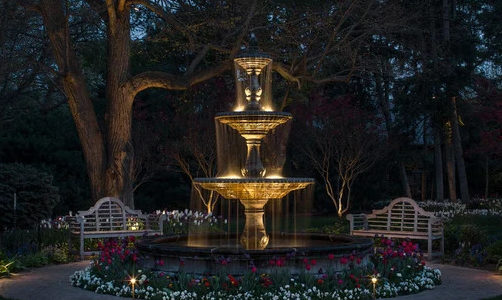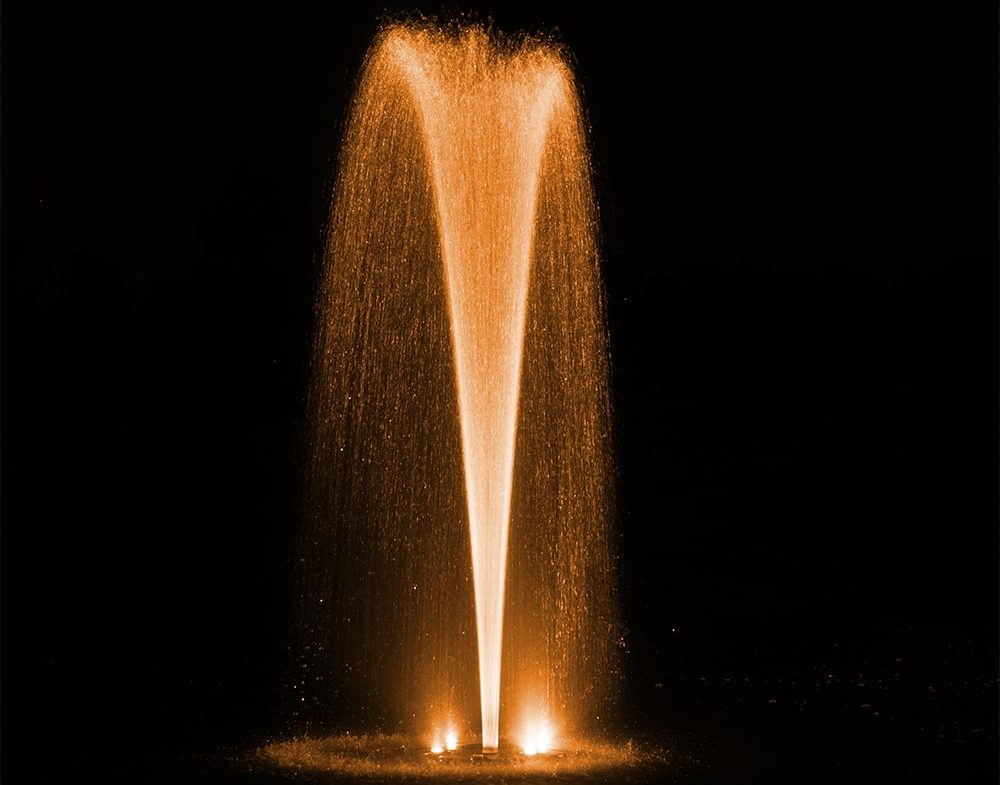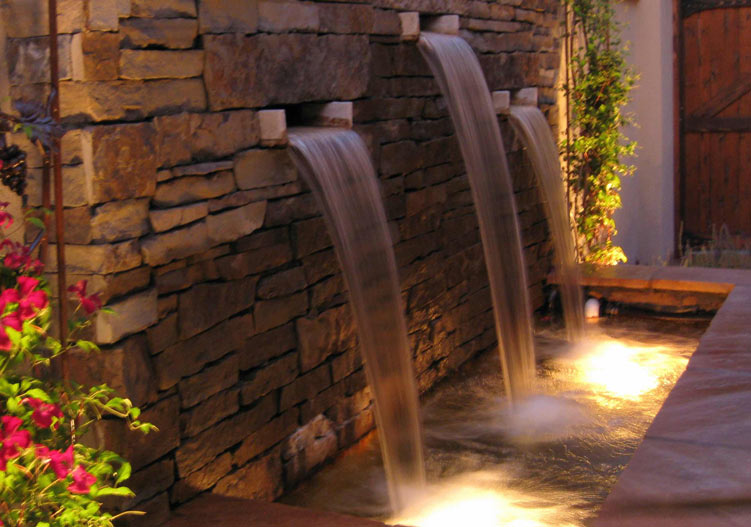The soothing sound of running water becomes even more enchanting with the addition of fountain lighting, bringing your water feature to life with elegance and splendor in your nightscape. As the water continuously moves, the light dances with it, creating a mesmerizing and fiery effect.
Fountains inherently possess a sculptural quality. If you have a fountain, it may consist of a single jet or a group of jets, displaying various styles and fountain effects. Some pre-made fountains come with built-in lights or offer optional light features for easy installation. However, sculptural fountains often lack integral lighting, necessitating a custom lighting design. The lighting approach can focus on illuminating the fountain’s structure while letting the water add its own sparkle. The goal is to enhance the shape and texture of the fountain, creating a captivating visual effect. Smaller fountains benefit from subtle lighting that complements their size and highlights their unique features. If you like color lighting, this is an excellent place to try it.
How to illuminate a fountain
The lighting design must carefully consider the water display’s configuration, taking into account factors such as the number of jets, the types of water effects (columns, streams, cascades, mounds, domes, or patterns), and the height and width of the display.
Now, let’s explore various techniques to illuminate some of the most popular fountain display types:
Tiered fountains:
Tiered and cascading fountains present a captivating flow of water as it gracefully descends from one level to the next, often featuring three distinctive tiers.
To achieve an impressive lighting effect for tiered fountains with multiple bowls, it is essential to submerge the lights in each tier or basin where the waterfall occurs. Illuminating the fountain solely from the ground would cast large shadows in the above tiers, compromising the visual appeal. For optimal results, a minimum of 3 lights should be strategically placed in each bowl to provide a beautiful 360º view. These fountains are designed to be admired from all sides and are often placed in circular driveways and entryways. For lighting the features in the upper tier basin, where the water originates, the fixtures may need to be repositioned at the edge of the lower pool to maximize the lighting effect.

Spouting fountains:
Spouting fountains are designed to shoot water into the air, featuring a central nozzle within a body of water, creating a captivating spray that rises from a partially submerged floating platform. These fountains can vary in size, ranging from large installations to more intimate ones.
The flowing water in spouting fountains can be utilized to conduct beams of light, resulting in a mesmerizing visual display. When a single jet or individual streams are used to create an upward pattern, each stream should have a minimum of two fixtures, ensuring the lighting effect is visible from all sides.
For fountains where jets produce streams across the water’s surface, each jet requires at least one fixture placed at the point of impact. Longer streams may need multiple fixtures to adequately cover the water effect, with one light capturing the end of the arch and another near the nozzle illuminating the starting point.
When multiple streams are formed using one pipe in a ring or other shape, the lighting needs to address all nozzle sprays in terms of width and height. This might not necessarily require one fixture per nozzle, but rather a group of fixtures to cover the entire display.
For spouts falling into the pool, creating widening ripple circles, an overhead light directed from a distance at an angle can create an intriguing effect with the ripples catching the light. The reflected ripples will be visible on any nearby background surface, adding movement to the overall lighted composition.
Special fixtures are available that allow lights to be positioned at the base of a fountain, directing the light upward into the fountain spray for a unique and enchanting effect.

Wall fountains:
Wall fountains, as their name suggests, are designed to be integrated into walls, making them space-efficient with a slim profile.
When it comes to lighting wall-mounted fountains, it’s essential to avoid creating heavy shadows. Placing the luminaires directly underneath the water spout should be avoided. The recommended technique is to position the luminaire with a narrow or medium beam just below the water surface, allowing the light to travel up the water spout, accentuating the mask against the surrounding surface. Alternatively, a wider beam lamp mounted farther to the front of the basin or pool can be used to eliminate undesirable shadows. Wider beam fixtures create a broader area of shimmering light from below the moving water, while narrower beams emphasize the water flow and mask.
For larger wall fountains or those with multiple spouts, a more intricate approach may be needed. Accent lighting of individual spouts with lower lumen outputs can be effective. Wider beam lamps can provide an overall wash. Placing the light at the front of the pool will create intriguing shadows on the lion mask’s features without casting shadows above the mask. This reveals deep shadows under the fountain ledges, contrasting with the illuminated streams of water.
Aerated water in the fountain should be illuminated from below, while a sheet fountain benefits from front lighting.
In slim-profile fountains where water flows smoothly over a smooth weir, it cascades as a wide sheet of water without air bubbles. To enhance its beauty, backlighting can be achieved by positioning a strip of light or puck light underneath the lip of the ledge.
Alternatively, a fixture can be placed in front of the falling water to create a sparkling effect on the water’s surface. The aim is to capture the water’s glass-like smoothness on top with agitation at the bottom, allowing the light to reflect off the water and provide subtle backlighting.
This lighting approach is akin to wall washing, with the light passing through the flowing water to illuminate the area behind it. The fixture should be placed in front, with its beam spread covering the height of the fall. If using two fixtures, they should be positioned close together to ensure their beam spreads overlap.
However, when lighting from the front, caution must be exercised to avoid potential glare caused by light bouncing off the water at an angle.

Trough fountains
Even in the smallest garden, courtyard, or roof garden, the bubbling water from a fountain bowl can add captivating interest. Enhance this delightful display by considering the installation of an aerator with a single underwater light to beautifully illuminate the aerated water.
In this setting, when the water is illuminated, its glimmering effect becomes a mesmerizing attraction, truly spectacular to behold.

Exterior Fountain Lighting
Take a moment to observe the surrounding space, as it presents unique opportunities to infuse drama into the fountain area. Utilizing downlighting from a nearby tree or the eave of a house can create a captivating spotlight effect, drawing attention to the fountain’s beauty. For added depth and intrigue, consider strategically placing multiple lights around the fountain.
To Sum Up
Illuminating fountains and pools at night can be a captivating challenge, and experimenting with different lighting effects will help you discover what works best for your landscape.
When lighting a fountain, it’s crucial to keep the focus on the fountain itself and not on the cords, wires, or hardware. Concealing lighting fixtures discreetly ensures that distractions are minimized, allowing the fountain’s beauty to shine. For optimal results, it’s recommended to install the lighting simultaneously with the fountain to hide cords effectively. If you have an existing fountain, some disassembly may be required to achieve proper concealment.
Using waterproof fountain fixtures is essential, especially for submersible lighting, to prevent water intrusion and ensure safety. Bright LED lights are ideal for underwater use, compensating for the light loss caused by submersion.
While choosing and installing fountain lights can be manageable with basic electrical knowledge, seeking advice from an expert for selecting and installing these dramatic lights can provide valuable guidance. Keep in mind that more complex fountains may require a more intricate installation process.


